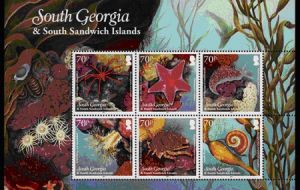MercoPress. South Atlantic News Agency
Set of six stamps dedicated to South Georgia unique shallow marine environment
 The first day cover will contain the six stamps removed from the border.
The first day cover will contain the six stamps removed from the border. Shadowed beneath South Georgia’s rugged mountains and glacial valleys lay a rich and colourful seascape of plants and animals. This shallow marine environment has received surprisingly little attention since it was first studied during the Discovery Expeditions in 1925. As South Georgia is situated just south of the Polar Front, where warmer waters from the north meet colder Antarctic water from the south, the region is home to a unique assemblage of South Atlantic and Antarctic animals.
The diverse marine fauna and flora of South Georgia is under threat from climate change and introduced species. Water temperatures have increased by 1-2 degrees Celsius in the last 80 years and visiting vessels may carry non-native species from more temperate waters on their hulls, in their ballast water, or attached to marine structures. In the past such non-native species would be unlikely to survive in the cold waters, but rising temperatures increase the probability of survival. If non-native species survive and thrive they are likely to do so at the expense of the natural flora and fauna.
In November 2010 the Shallow Marine Surveys Group (SMSG) undertook a dive survey of the shallow bays of the north coast of South Georgia to investigate the shallow marine biodiversity and provide a baseline for future climate change monitoring. As part of this work photographs were taken of most of the species encountered. A selection of these images has been beautifully transformed into watercolour by Leigh-Anne Wolfaardt for reproduction as stamps.
The first stamp features the predatory ten-legged sea spider (Decolopoda australis), which is unusual in having 10 legs rather than the more typical 8, and is shown here feeding on sponges, anemones and bryozoans.
The pink cushion seastar, Odontaster validus, features on the second stamp. This brightly coloured and conspicuous member of the benthic community is found throughout the Antarctic and sub-Antarctic oceans.
The third stamp features the white tipped nudibranch, Flabellina falklandica, which as its name suggest, also occurs in the Falkland Islands and throughout southern South America.
The branching sea cucumber (Heterocucumis steineni), which is featured on the fourth stamp, is common to rock wall habitats. Its highly branched feeding tree can be seen erupting from dense, colourful assemblages of colonial sea-squirts and sponges.
The iconic giant Antarctic isopod Glyptonotus antarcticus (fifth stamp) is a typical Antarctic species, which demonstrates the so-called “gigantism” characteristic of many cold-water species, growing up to 20 cm in length and 70 g in weight.
Finally the sixth stamp features the South Georgia top shell Margarella tropidophoroides, which is found only in South Georgia waters. Such endemic species are often found on isolated islands such as South Georgia.
The first day cover will contain the six stamps removed from the border. The release date was 1 January, 2012




Top Comments
Disclaimer & comment rules-

-

-

Read all commentsWhy don't you lick those stamps, stamp them on your @rse, on a box addressed to the UK?
Feb 14th, 2012 - 12:04 pm 0Why don't you - we'd love to see you :-)
Feb 14th, 2012 - 01:20 pm 0Are they even called South Georgia Islands in Faggotina? Haven't the Politburo renamed them after the glorious eternal leader Nestor (South Nestor Islands) in some sacchariney attempt to pretend that they once owned the islands (never did) and simple geographic proximity is the UN's main method of selecting sovereignty.
Feb 14th, 2012 - 04:26 pm 0Those Chileans are totally forked if that's the case.
Commenting for this story is now closed.
If you have a Facebook account, become a fan and comment on our Facebook Page!